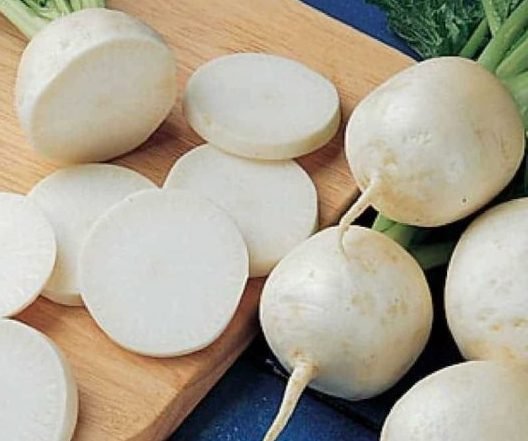 Image 1 of 2
Image 1 of 2

 Image 2 of 2
Image 2 of 2

Turnip tokyo (Japanese Turnip)
Tokyo Turnips taste like a cross between a radish and a turnip. The skin does not require peeling, only a quick scrub under water. Unlike other Turnip varieties, Tokyo Turnip can be eaten raw and is even preferred that way by some; Yet, due to the cyanoglucosides, a chemical Tokyo turnip contain, they can taste bitter to certain people. Steamed they are buttery-sweet and delicate.
They are a good source of Vitamin C as well as Fibre, however their greens contain even more nutritional value: Some people consume those turnips exclusively for their greens, which are rich in vitamins A,B, C and K, as well as Folate, Calcium and Manganese- The leaves are very good in kimchi.
Available from June to September
Tokyo Turnips taste like a cross between a radish and a turnip. The skin does not require peeling, only a quick scrub under water. Unlike other Turnip varieties, Tokyo Turnip can be eaten raw and is even preferred that way by some; Yet, due to the cyanoglucosides, a chemical Tokyo turnip contain, they can taste bitter to certain people. Steamed they are buttery-sweet and delicate.
They are a good source of Vitamin C as well as Fibre, however their greens contain even more nutritional value: Some people consume those turnips exclusively for their greens, which are rich in vitamins A,B, C and K, as well as Folate, Calcium and Manganese- The leaves are very good in kimchi.
Available from June to September
Tokyo Turnips taste like a cross between a radish and a turnip. The skin does not require peeling, only a quick scrub under water. Unlike other Turnip varieties, Tokyo Turnip can be eaten raw and is even preferred that way by some; Yet, due to the cyanoglucosides, a chemical Tokyo turnip contain, they can taste bitter to certain people. Steamed they are buttery-sweet and delicate.
They are a good source of Vitamin C as well as Fibre, however their greens contain even more nutritional value: Some people consume those turnips exclusively for their greens, which are rich in vitamins A,B, C and K, as well as Folate, Calcium and Manganese- The leaves are very good in kimchi.
Available from June to September
